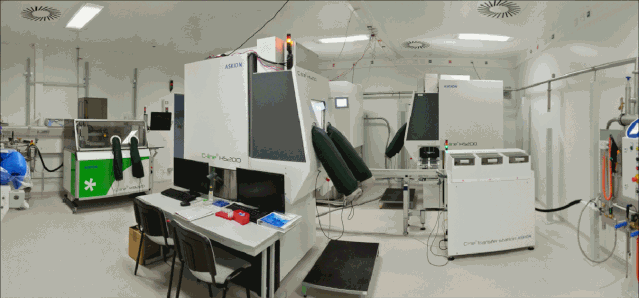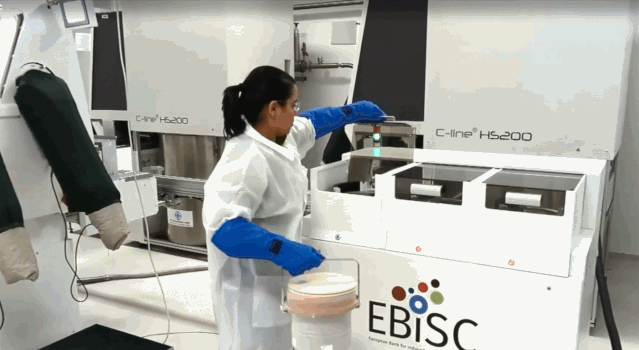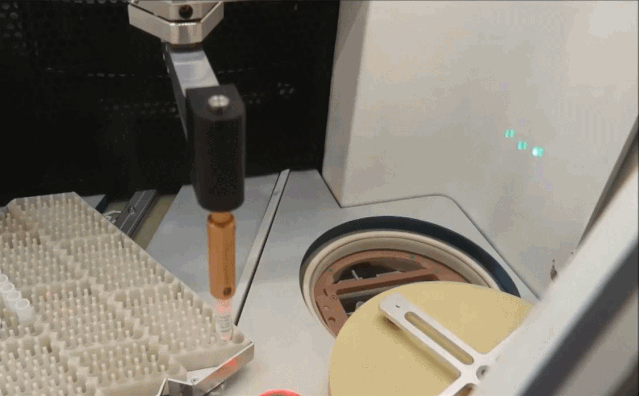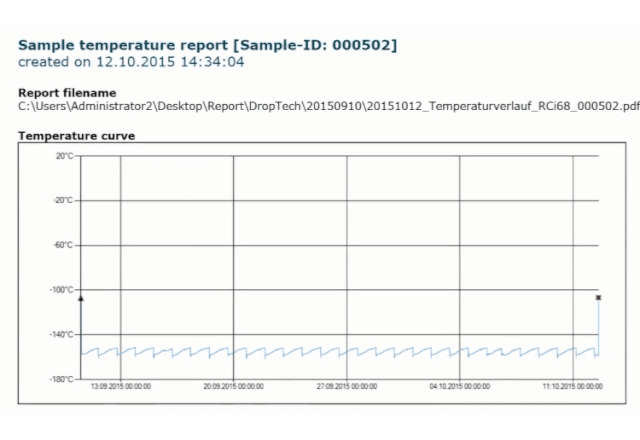视频来源:德国Fraunhofer IBMT生物银行
Happy new year!
新的一年又来到了,过去的2019年,小熊康康我和大家正式见面,带大家认识了我美丽的家乡格拉(Gera),走进了我们的工厂,还介绍了我们的产品。通过我们的介绍,想必大家对ASKION C-line自动化液氮生物样本存储管理系统和这套系统里面的每一个设备都已经有了一个初步的了解。那么,这套系统是如何工作的呢?世界各国都有哪些有名的机构在使用这套系统呢?接下来的日子,我会带大家走遍世界各国,去探访分布在世界各地正在使用我们产品的生物银行,让我们现在就出发吧。
一站,我们首先从德国开始吧!这一期,我要带大家一起来了解德国Fraunhofer IBMT生物银行。

德国Fraunhofer-Gesellschaft
(弗劳恩霍夫协会)
说到德国Fraunhofer IBMT(以下简称IBMT),就要先给大家科普一下Fraunhofer-Gesellschaft(弗劳恩霍夫协会)。它是德国、乃至欧洲很大的应用科学研究机构。而我们的用户——Fraunhofer IBMT,由医学生物技术、超声和生物医学工程三个部门组成,是协会旗下在医疗生物技术、低温(生物)技术和实验室自动化领域,负责设备和技术开发的机构。
10多年来,IBMT一直致力于干细胞研究,并在工业和临床的生物库中储存了大量的细胞系,以及用于低温保存有价值的样本(包括液体、细胞、组织碎片等)。

EBiSC在德国苏尔茨巴赫市
(Sulzbach, Germany)的生物银行
2014年,IBMT发起了EBiSC(诱导多能干细胞欧洲样本库)项目,这是一个由26个欧洲的团体组织,共同建立的一个重要设施,以方便研究人员进行诱导多能干细胞的收集、检测和分配。
由于细胞材料的储存至关重要,IBMT将其在冷冻贮藏和生物银行技术领域的专长,与前沿冷冻方法和高性能、无外源介质的发展相结合,用于相关细胞系统的冷冻保存。
对于细胞的扩增和冷藏,自动化设备的应用显得尤为重要。因此,Fraunhofer IBMT在德国苏尔茨巴赫市(Sulzbach, Germany)建立了一个可确保EBiSC所有细胞系的一致性的自动化生物银行,全部采用ASKION C-line全自动化液氮生物样本存储管理系统。

ASKION C-line®
自动化液氮生物样本存储管理系统
The ASKION C-line is a fully automated liquid nitrogen based cryo-storage system. Basedon Fraunhofer’s research, the system provides a closed-cold-chain below -100℃ and guarantees nearly ice-free conditions inside the cryo tank.
ASKIONC-line是一套全自动化液氮低温存储管理系统。弗劳恩霍夫研究中心的研究数据显示,该系统提供了一条低于-100℃以下的不间断冷链,同时可确保存储罐内部的无霜环境。

Work Bench自动化程序降温工作台
The corresponding cryo work bench allows samples sorting at cryogenic temperaturesas well as computer control freezing.The cryo tank is managed by database, thedemand barcodes for process control, every vial, insert and transport containeris labeled for identification.
配套的Work Bench程序降温工作台可为样本提供深低温操作环境,同时可进行准确的程序化降温。整套系统由数据库进行管理,所有的样本管、板架及运输容器均带有条码,以便程序识别和管理。
Vialbarcodes are unique and needed to be added to database to get with samplesinformation, such as ID, vial format, cell line to facilitate sample sorting.
样本管条码和其他信息如编码、规格、种类一起录入到数据库中,以便统一管理。
Prepare sample in vials, and transfer to the WorkBench that consists of low temperature handling space and controlled ratefreezer.The cryopreservation process is controlled by temperature sensor in acontrol vial.Freezing rates can be defined on a sample specific bases via usinginterface. The cryo work bench covers a range of temperature from roomtemperature to -130℃.Up to three sample baskets can be processed independently inparallel.
将样本放入冻存管,然后转移至Work Bench程序降温工作台中,其可提供深低温的操作环境及样本程序化降温。降温程序由对照管内的温度探头进行控制。降温速率可通过软件根据样本类型的不同进行设置。深低温操作区可提供室温至-130℃的低温环境。可使用三个升降台来同时处理不同的降温程序。

ASKION C-line®
自动化液氮生物样本存储管理系统
After successful freezing, the insert containing the sample vials is transfer to thecold transport container in cryogenic conditions.The closed transport containerkeeps the samples in a dry and cold nitrogen atmosphere, and has capacity of 48vials.One transport container can be used for storage as well as movableprocesses, serving all tanks at the same time.The container is placed in thetransfer station that manages up to three containers in parallel via theautomated trail system.The container is linked to transport station by barcodescanning. The storage position of the samples inside the tank can be assignedautomatically by the software or manually by the user.
程序降温完成后,样本将在低温环境下随板架放入到专门的低温运输容器中。封闭的运输容器为样本提供了干燥、低温的气相液氮环境,可同时放置48个1.8ml规格冻存管。运输容器可用来短暂存储和运输样本,可应用在所有的存储系统上。运输容器放置在运输站中,后者可通过自动化轨道系统同时运输多达三个运输容器。运输容器通过条码扫描与运输站进行交互。样本在存储区中的位置可通过软件自动分配,也可由用户自定义分配。

ASKION C-line®
自动化液氮生物样本存储管理系统
样本单支抓取
During the storage process, the handling space above the tank is cooled down to -100℃ by liquid nitrogen.At destination tank, the transport container isdocked into the isolated cryogenic handling space.A cryo tank designed for1.8ml cryo vials has capacity for about 20,000 samples and separated into 6racks with 9 drawer levels each.After retrieving the selected drawer in thehandling space, the picking place’s gripper transferthe samples one by one from the docked container to its final position in thedrawer.
在样本存储时,存储区上方的操作区将通过液氮降至-100℃以下。运输容器被运输至目的存储区后,将被锁定至操作区中。单台存储系统可容纳2万余份1.8ml规格冻存管,分别存放在6个扇形冻存架中,每个存储架由9层存储板组成。指定的存储板提呈至操作区后,操作区内的机械臂将运输容器内的样本依次转移到存储板的指定位置中。
Eachsample is controlled before sorting by internal scanning on the side or thebottom of the vial, different sorts of barcode can be recognized.After thesample sorting, the drawer moves back into the tank and container returnsautomatically to the transfer station.During the whole process, temperaturesensors inside the tank allow a continuous control of the conditions and recordsample specific temperature profiles.
在转移时,每个样本都会通过侧面或底部条码扫描进行二次确认,如编码有误则可识别出来。所有样本转移完毕后,存储板会退回至存储区中,而运输容器则自动返回至运输站。在整个过程中,存储区中的多个温度探头对操作及存储环境进行着持续的监测和控制,并全程记录样本的温度变化。

ASKION C-line®
自动化液氮生物样本存储管理系统
样本管理软件
The system also records the events such as day and night nitrogen filling ortemperature shifts caused by sample storage or retrieval.The platform is basedon self-manage database containing every sample’s temperatureinformation.For each processing of sample, a storage report can be extractedfrom software.
此外,系统还实时记录着各类事件信息,如日常液氮补充、样本存储及提取导致的温度变化等。整个平台的运行依托于容纳每一个样本温度信息的自管理数据库。对每个处理过的样本,用户均可从软件中导出相关数据报告。

IBMT & EBiSC 的ASKION C-line®
自动化液氮生物样本存储管理系统
由于ASKION C-line自动化液氮生物样本存储管理系统操作简便、性能优异,IBMT已经安装了十多台相关设备,用于包括干细胞在内的多种珍贵细胞的存储,同时还存储部分传染性样本。

IBMT所长、EBiSC2项目协调员
Heiko Zimmermann教授
IBMT所长、EBiSC2项目协调员Heiko Zimmermann教授也给予了高度评价:“学术界和工业界对hiPSC用户的需求一直都在不断发展,而要使这些资源的价值高,则要通过产品的升级和自动化以减少运营成本。ASKION C-line自动化液氮生物样本存储管理系统在这方面给我们做出了贡献。“